Street go-karting in Japan sounds like something that shouldn’t be allowed. And yet, it is. You drive a tiny kart on real roads, surrounded by Tokyo taxis and delivery trucks, with tourists and locals pointing their phones at you. It’s bizarre, fun, but it’s also one of those activities where the fine print matters. From license requirements and how to book to safety conditions and how locals really feel about it, here’s everything you need to know before getting behind the wheel.
- Part 1: Which Driving License Do You Need to Participate in Street Go-Karting in Japan
- Part 2: How to Book Your Go-Kart Tickets at Popular Locations
- Insider story time: What happened to MariCar?
- Part 3: Safety, Regulations, and Public Sentiment
- Part 4: Tips to Enjoy Street Go-Karting
- Part 5: Participant Reviews: What People are Saying
- Part 6: Alternatives to Street Go-Karting
- Wrapping It Up: Your Street Go-Karting Adventure
Part 1: Which Driving License Do You Need to Participate in Street Go-Karting in Japan
To drive a go-kart on public roads in Japan, you need to be at least 18 years old and hold a license that is recognized under Japanese traffic law. There are several options depending on where you’re from.
- If you live in Japan:
If you already have a local license, you can use it without any extra paperwork.
- If you’re from Switzerland, Germany, France, Monaco, Belgium, or Taiwan:
Visitors from Switzerland, Germany, France, Monaco, Belgium, and Taiwan can use their domestic license together with an official Japanese translation. This translation must be issued either by the Japan Automobile Federation (JAF), or by an embassy or a local organization (German Automobile Federation, the Taiwan-Japan Relations Association).
- If you’re from any other country:
This is the most common option for travelers. You must obtain an International Driving Permit (IDP) in your home country before traveling to Japan. The permit is valid for one year from the date of issuance.
But be careful: Japan only accepts IDPs issued under the 1949 Geneva Convention. That means most permits from the US, Canada, Australia, and a few other countries are valid. But permits under the 1968 Vienna Convention (common in many European countries) will not be accepted. Check the convention type before applying.
In the US, for example, you can get an IDP from AAA. It costs $20 and takes just a few days. You’ll need to fill out an application form, show your regular driver’s license, and a couple of passport-style photos.
- For US military stationed in Japan:
If you’re stationed in Japan with the US military, you can use your SOFA driving permit. Most go-kart companies also accept a US license shown together with your military ID, but you should confirm this with the shop before booking.
Part 2: How to Book Your Go-Kart Tickets at Popular Locations
Once your license is sorted, you’re ready to secure your spot. Several companies operate these tours. Perhaps you’ve heard of MariCar, but they’ve had to distance themselves from that for trademark reasons. I’ll tell you more about that later.
And Go-karting tours aren’t just limited to Tokyo – you can also find them in Osaka and Okinawa. But since Tokyo is the most visited city, we’ll start there.
Mario Kart in Tokyo
Most people do it in Tokyo. That’s where you’ll find the widest choice of routes, companies, and time slots. Some tours stay near popular spots like Shibuya or Tokyo Tower. Others go a bit further out or run at night.
Use the comparison table below to get an overview of what each company offers:
| Location | Duration | Price From | Included | Landmarks | Online Booking | Reviews |
|---|---|---|---|---|---|---|
| Akihabara (Tokyo’s manga & gaming district) | 1 or 2 hours | ¥11,000 | Costumes | Akihabara Electric Town, Mandarake Complex, Radio Kaikan | Viator | 5/5 |
| Asakusa (Tokyo’s historical district) | 1 hour | ¥16,000 | Costumes | Sensoji Temple, Nakamise Shopping Street, Sumida River | Klook | 4.8/5 |
| Shibuya (Shopping & entertainment district) | 1 hour | ¥15,00 | Costumes | Shibuya Crossing, Hachiko Statue, Yoyogi Park | Viator | 5/5 |
| Tokyo Bay (Scenic coastal area) | 1-2 hours | ¥17,690 | Costumes, Bluetooth Speaker | Rainbow Bridge, Odaiba Seaside Park, Tokyo Tower | Klook | 4.9/5 |
Go-Karting in Osaka and Okinawa
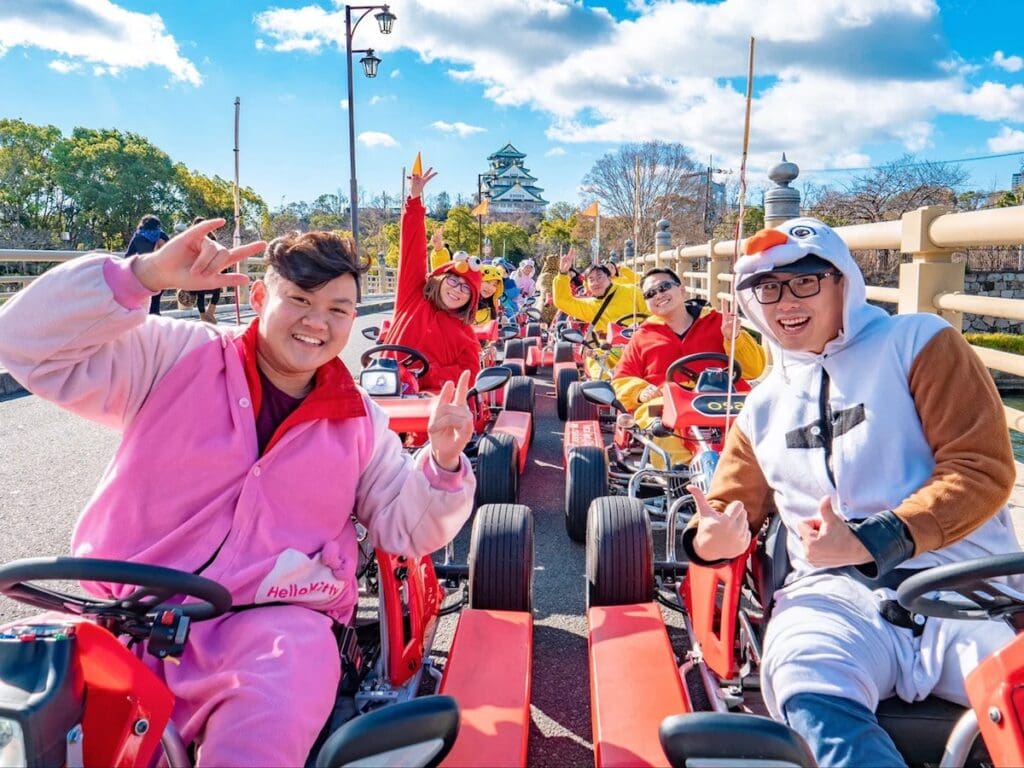
Go-kart tours are also available in Osaka and Okinawa, but options are more limited. In Osaka, the routes often run through areas like Namba or near Osaka Castle. In Okinawa, it’s more spread out, with less city traffic, and more coastal roads and sea views. If you’re already planning to visit either area, it can be worth checking, but don’t expect the same number of choices as in Tokyo.
Note: Weather is something to keep in mind. Tours usually run in light rain, but driving a go-kart while soaking wet might not be as fun as it sounds. Some companies let you cancel for free up to 24 hours before the tour, but not all. Always check the cancellation policy before booking.
Choose Your Costume
When you show up for your tour, you get to the fun part: choosing your costume. You might have seen photos of people driving around in Mario or Luigi outfits, but that’s not really a thing anymore. Go-kart companies used to offer Nintendo-themed costumes, but they were forced to stop after a legal battle with Nintendo. Here’s what happened.
Insider story time: What happened to MariCar?
You’ve probably heard about “Mario Kart in Tokyo”. The nickname came from street go-kart companies in Japan that used the game’s popularity to attract tourists, offering costumes of characters.
Nintendo didn’t like that.
In 2017, they sued one of the companies: Mari Mobility Development Inc., better known as MariCar. The name, just two letters off MarioKart, didn’t help their case.
In 2020, MariCar lost and was ordered to pay 50 million yen (about $475,000 USD at the time). The company rebranded as “Street Kart.”
But that same year, Japan closed its borders due to COVID, cutting off Street Kart’s main source of customers: foreign tourists.
They launched a crowdfunding campaign to stay afloat, but it failed. They aimed for two million yen (around $18,000) and raised just ¥11,569 yen (barely over $100 USD) from four backers. One big mistake: they used Campfire, a Japanese platform, even though most of their customers were overseas.
Still, Street Kart survived. They reopened in 2023 along with the return of international tourism.
But visit their site today and you’ll see a pop-up making it clear: they have no link to Mario Kart and no longer offer Mario-themed costumes.
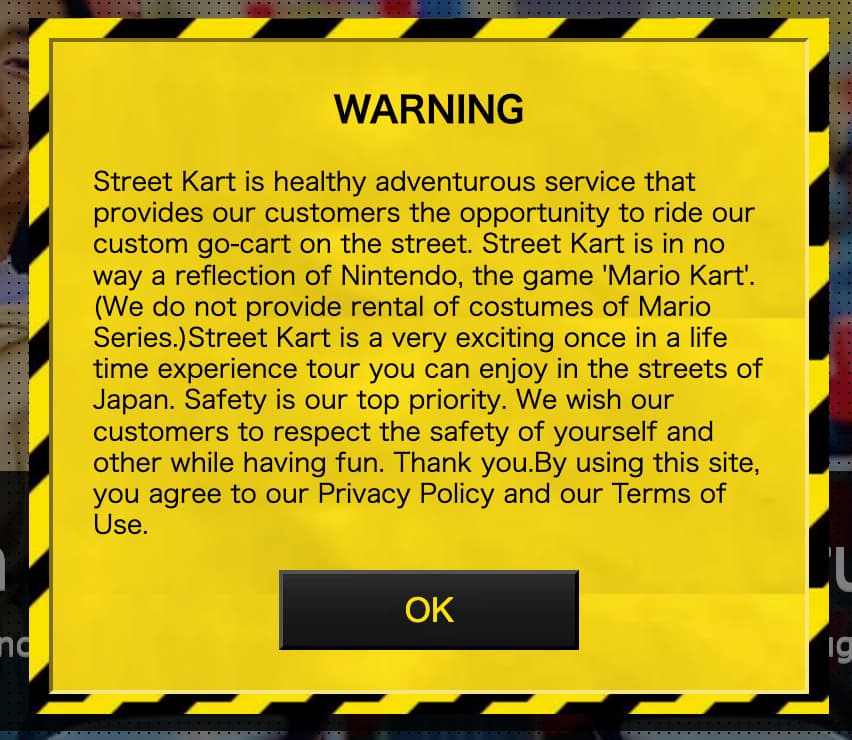
Now, back to the main topic.
Don’t worry though, there’s a wide variety of other fun costumes to choose from. Most places offer a random mix of superhero, animal, or generic cosplay costumes. And if you prefer, you can skip the costume altogether.
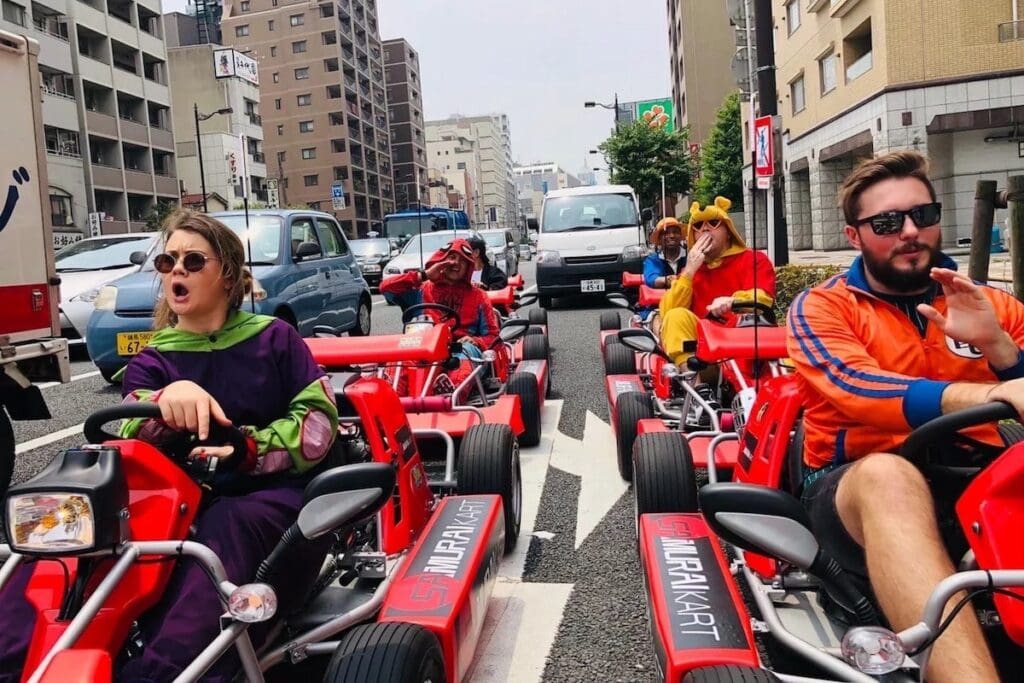
Part 3: Safety, Regulations, and Public Sentiment
Although it’s obvious, there’s one crucial aspect I couldn’t leave out of this guide: safety and regulations.
Road Rules & Safety
Street go-karting in Japan adheres to the same traffic rules applicable to all road users. In regards to the law, you’re driving a real vehicle on real roads. As such, you’ll have to stop at red lights, yield to pedestrians, stay within speed limits, and unfortunately, no, you won’t be able to throw bananas at other drivers 🙁
Safety instructions will be given before the tour, and following them is paramount to enjoy a fun and safe experience.
It’s also worth noting that helmets aren’t mandatory for go-kart drivers in Japan, but the rental shops may offer them for those who want to wear one.
Legal Regulations
To participate in street go-karting, you need a valid international driving permit (Class A), a translation of your national driving license, or a Japanese one, as I detailed in the Part 1 of this guide. There’s no room for negotiation here as it’s a requirement of Japanese law.
And of course, you cannot participate in the tour if you’ve been drinking.
What do locals think about it?
This is a question I get a lot. And if you read comments online, Japanese locals have mixed feelings about the go-karting phenomenon.
Some find it fun, sometimes waving at, smiling, or even encouraging participants.
However, not everyone is in favor. Concerns exist regarding noise and safety, especially since drivers are visitors unfamiliar with Japanese traffic rules.
This lack of support was proved when MariCar attempted to raise money to stay afloat during COVID. They managed to get only 4 backers in total, and we can imagine they might have been the owners and employees themselves.
Most foreigners living in Japan don’t like it though. You can find countless thread on Reddit about it. If you know someone living here, they will probably discourage you from joining a go-kart tour.
But the truth is, most people don’t really care. Kart tours do not go through residential areas, so locals will only see them when going to Shibuya, Shinjuku, or other big central areas. And a few small karts amongst the craziness of say, a Shibuya Crossing, are barely noticeable. I personally almost never notice go-karts in the streets unless they’re really a few meters from me.
Overall, you don’t need to worry too much about it. Just remember to respect local culture, adhere to traffic rules, and follow safety measures to ensure go-karting remains a fun experience for both drivers and locals.
Part 4: Tips to Enjoy Street Go-Karting
What to Wear
You can wear a costume over your usual clothes, but depending on the season, you might want to adjust.
In summer, a T-shirt and shorts are recommended as the weather can get really hot. But in winter, layer up as driving in the open kart can get chilly (and you’ll often be stopping at traffic lights).
And regardless of the season, closed-toe shoes are a must.
Best Time to Go-Kart
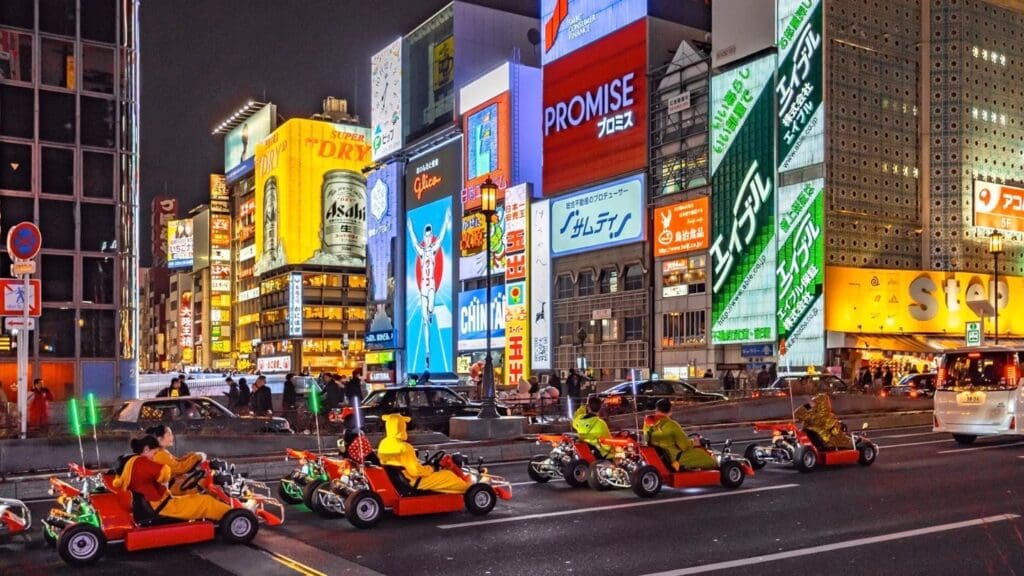
The best time to go street go-karting really depends on the kind of experience you’re after.
Daytime offers excellent visibility and nice views. But I’d recommend going for the evening, though, to enjoy the city’s neon lights and night atmosphere. Driving through Shibuya, Shinjuku, or Namba at night vs day is a completely different experience.
Capture the Best Moments
You might be tempted to snap a selfie while you’re tearing down the asphalt, but I’d advise against it. Remember the safety instructions? Keeping your hands on the wheel is one of them.
Instead, I recommend a body-mounted action camera to capture your experience hands-free. Some tour providers even offer action photos as part of their package.
Also, don’t worry about missing a good shot. The guides are pretty good at figuring out the best photo spots and will gladly help you capture those cool Instagram shots.
Part 5: Participant Reviews: What People are Saying
Street go-karting in Tokyo is more than just an activity – it’s an exhilarating, unforgettable adventure.
At least, this is what most reviews say. Here are some sentiments shared by other participants (reviews are from Klook and TripAdvisor):
“This was a really fun experience driving over the streets of Tokyo! I would thoroughly recommend this for anyone who loves driving and wants a novel way of seeing the sights!“
Street Go Karting Experience in Akihabara
“Best thing we did in Tokyo! Tour guides are great fun and elevate the experience massively. Felt safe the whole time as the instructions from the guides took all the worry out of it. Would definitely do again!
Small Group Go Kart Experience in Shinjuku
With a carefully planned itinerary and a guide always ready to capture those memorable moments, it seems like street go-karting provides not just fun, but also a great way to explore the city:
“Great way to start the trip. It allowed us to drive around the streets of Tokyo to see what we wanted to go and see. The guide has planned a great itinerary and is always taking photos so you can remember your trip.“
Street Go Karting Experience in Akihabara
The thrill of the drive, coupled with the iconic sights of Tokyo and the attentiveness of the guides, is enough to have some participants wishing to do it all over again:
“Had a great time driving through Tokyo. The guide took great pics and was very attentive stopping and asking if we were OK. Would definitely do it again when I go back.“
Street Go Karting Experience in Akihabara
And the experience isn’t just limited to the young or fit. As one participant points out, this is an experience for everyone, regardless of age or body size:
“…I want to make a special mention that this attraction is suitable for all ages and body sizes. I am a 63-year-old guy who is heavy – 145kg (320 pounds)… if an old fat guy can ride this and have a good time, anyone should be able to.“
Street Kart Shibuya
Part 6: Alternatives to Street Go-Karting
While street go-karting is a fun experience, it might not be for everyone, whether it’s due to personal preference or inability to meet the driving requirements. Luckily, Tokyo offers a myriad of unique activities for exploring the city:
- For instance, you can opt for a cycling tour around Tokyo to experience the city’s hustle and bustle at a leisurely pace.
- If you want a more traditional experience, rickshaw rides in Asakusa provide a unique and culturally immersive way to explore the city.
- Alternatively, you might prefer a bird’s eye view of Tokyo. Helicopter sightseeing tours provide a stunning perspective on the metropolis, allowing you to marvel at the city’s sprawling landscape from a vantage point few get to experience.
Or are you looking for more fun pop-culture activities in Japan? Apart from street go-karting, the country is home to several anime theme parks that offer immersive experiences.
Wrapping It Up: Your Street Go-Karting Adventure
Driving around Tokyo’s bustling streets is thrilling, fun, and incredibly memorable. Here are the takeaways from this guide:
- Make sure you carry your international driving permit to be able to participate.
- The go-karting tours are available in various locations across Tokyo, but also in Osaka and Okinawa.
- Depending on the package you choose, your tour might last anywhere from one to three hours.
- Booking in advance is necessary, especially for groups or during peak tourist seasons.
- Keep in mind the safety regulations and driving rules. Even though it’s fun, it’s a real road driving experience.
That sums up the go-karting experience in Japan. Now we’ll tackle the questions I’ve heard the most often in the bonus section of this guide.
Bonus: FAQ
Q: Is it worth it to try street go-karting?
A: To me (and looking at the reviews, to other customers), it’s a resounding YES. It’s a unique, memorable, and fun-filled adventure.
Q: Is a driving license necessary to participate?
A: Yes, you need a valid driving license to drive a street go-kart in Japan.
Q: Can I use my international or country-specific license?
A: Yes, both international and certain country-specific licenses are accepted, provided they are valid and appropriate for driving motor vehicles in Japan. Please check the Driving License Requirements section of this guide for more detailed information.
Q: How much does a street go-karting tour cost?
A: Prices can range from ¥8,000 to ¥15,000 ($55 to $105) per person, depending on the duration and route of the tour.
Q: How long does a tour last?
A: Tours can last between 1 to 3 hours, depending on the package chosen.
Q: When’s the best time to go karting?
A: You can enjoy go-karting at any time of the day. Evening rides can be particularly fun with the city lights on, but each time of day offers a unique experience.
Q: Do I need a reservation for the go-kart tour or can I just show up?
A: It’s always best to reserve your spot in advance. Most companies are often fully booked several days or even weeks ahead, especially the popular ones in Tokyo.
Q: I don’t have a driving license. Are there options like two-seater karts or alternate transportation methods?
A: No, unfortunately. Most companies offer only single-seater karts, and they don’t typically provide alternate means of transportation for those without a license.
Q: Are there age restrictions for driving the go-karts?
A: Yes, participants need to be at least 18 years old to drive.
Q: Are there any weight or height restrictions?
A: Most companies do not have specific height or weight limits. However, if you’re worried that you might not fit into the kart or that your feet won’t reach the pedals, it’s worth checking directly with the company.
Q: Can I bring my kids along? Are there two-seater karts available?
A: Most companies only have single-seater karts, so kids usually can’t participate as passengers. It’s always best to confirm with the specific company, just in case.
Q: What about the Mario/Nintendo based costumes I’ve heard about?
A: Companies are no longer offering Mario/Nintendo based costumes due to copyright issues. But don’t worry, there’s still a fun variety of costumes to choose from!
Q: How big are the groups?
A: Group sizes are usually around 6 to 8 participants, but some tours go up to around 15 go-karts.
Q: Are there safety measures like seatbelts?
A: Go-karts typically don’t have seatbelts as they are low-speed vehicles. Note that there’s always a English-speaking professional guide leading the group.
Q: What happens if there’s bad weather like rain or snow?
A: If the weather turns out bad, the tour might get canceled by the operator. In this case, you will receive a full refund.
Q: Can I cancel my reservation without charge?
A: Cancellation policies can vary by company. It’s best to check the company’s terms and conditions before booking for their specific policy.

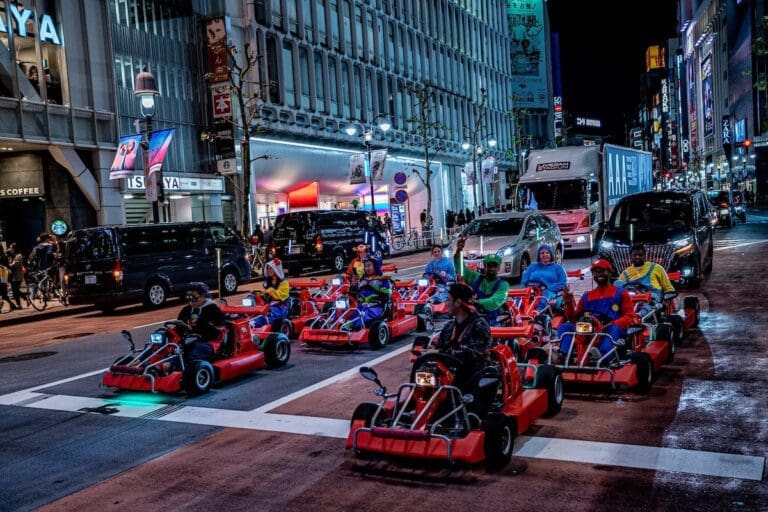
Comments are closed.